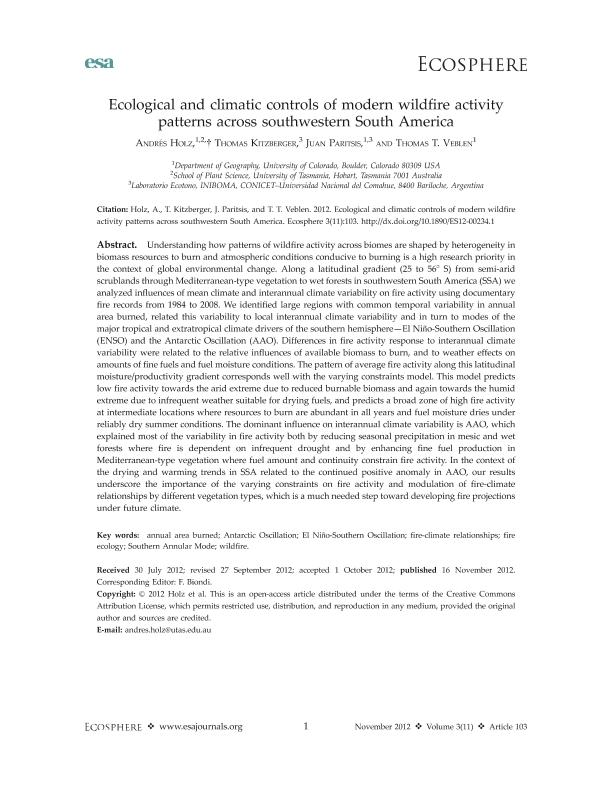Mostrar el registro sencillo del ítem
dc.contributor.author
Holz, Andrés

dc.contributor.author
Kitzberger, Thomas

dc.contributor.author
Paritsis, Juan

dc.contributor.author
Veblen, Thomas

dc.date.available
2019-03-08T21:39:05Z
dc.date.issued
2012-11-16
dc.identifier.citation
Holz, Andrés; Kitzberger, Thomas; Paritsis, Juan; Veblen, Thomas; Ecological and climatic controls of modern wildfire activity patterns across southwestern South America; Ecological Society of America; Ecosphere; 3; 11; 16-11-2012; 1-25
dc.identifier.issn
2150-8925
dc.identifier.uri
http://hdl.handle.net/11336/71320
dc.description.abstract
Understanding how patterns of wildfire activity across biomes are shaped by heterogeneity in biomass resources to burn and atmospheric conditions conducive to burning is a high research priority in the context of global environmental change. Along a latitudinal gradient (25 to 56° S) from semi-arid scrublands through Mediterranean-type vegetation to wet forests in southwestern South America (SSA) we analyzed influences of mean climate and interannual climate variability on fire activity using documentary fire records from 1984 to 2008. We identified large regions with common temporal variability in annual area burned, related this variability to local interannual climate variability and in turn to modes of the major tropical and extratropical climate drivers of the southern hemisphere-El Niño-Southern Oscillation (ENSO) and the Antarctic Oscillation (AAO). Differences in fire activity response to interannual climate variability were related to the relative influences of available biomass to burn, and to weather effects on amounts of fine fuels and fuel moisture conditions. The pattern of average fire activity along this latitudinal moisture/productivity gradient corresponds well with the varying constraints model. This model predicts low fire activity towards the arid extreme due to reduced burnable biomass and again towards the humid extreme due to infrequent weather suitable for drying fuels, and predicts a broad zone of high fire activity at intermediate locations where resources to burn are abundant in all years and fuel moisture dries under reliably dry summer conditions. The dominant influence on interannual climate variability is AAO, which explained most of the variability in fire activity both by reducing seasonal precipitation in mesic and wet forests where fire is dependent on infrequent drought and by enhancing fine fuel production in Mediterranean-type vegetation where fuel amount and continuity constrain fire activity. In the context of the drying and warming trends in SSA related to the continued positive anomaly in AAO, our results underscore the importance of the varying constraints on fire activity and modulation of fire-climate relationships by different vegetation types, which is a much needed step toward developing fire projections under future climate.
dc.format
application/pdf
dc.language.iso
eng
dc.publisher
Ecological Society of America

dc.rights
info:eu-repo/semantics/openAccess
dc.rights.uri
https://creativecommons.org/licenses/by/2.5/ar/
dc.subject
Annual Area Burned
dc.subject
Antarctic Oscillation
dc.subject
El NiÑO-Southern Oscillation
dc.subject
Fire Ecology
dc.subject
Fire-Climate Relationships
dc.subject
Southern Annular Mode
dc.subject
Wildfire
dc.subject.classification
Otras Ciencias Biológicas

dc.subject.classification
Ciencias Biológicas

dc.subject.classification
CIENCIAS NATURALES Y EXACTAS

dc.title
Ecological and climatic controls of modern wildfire activity patterns across southwestern South America
dc.type
info:eu-repo/semantics/article
dc.type
info:ar-repo/semantics/artículo
dc.type
info:eu-repo/semantics/publishedVersion
dc.date.updated
2019-02-12T16:54:15Z
dc.journal.volume
3
dc.journal.number
11
dc.journal.pagination
1-25
dc.journal.pais
Estados Unidos

dc.journal.ciudad
Washington DC
dc.description.fil
Fil: Holz, Andrés. University of Colorado; Estados Unidos
dc.description.fil
Fil: Kitzberger, Thomas. Consejo Nacional de Investigaciones Científicas y Técnicas. Centro Científico Tecnológico Conicet - Patagonia Norte. Instituto de Investigaciones en Biodiversidad y Medioambiente. Universidad Nacional del Comahue. Centro Regional Universidad Bariloche. Instituto de Investigaciones en Biodiversidad y Medioambiente; Argentina. Universidad Nacional del Comahue. Centro Regional Universitario Bariloche. Laboratorio de Ecotono; Argentina
dc.description.fil
Fil: Paritsis, Juan. Consejo Nacional de Investigaciones Científicas y Técnicas. Centro Científico Tecnológico Conicet - Patagonia Norte. Instituto de Investigaciones en Biodiversidad y Medioambiente. Universidad Nacional del Comahue. Centro Regional Universidad Bariloche. Instituto de Investigaciones en Biodiversidad y Medioambiente; Argentina. University of Tasmania; Australia. University of Colorado; Estados Unidos
dc.description.fil
Fil: Veblen, Thomas. University of Colorado; Estados Unidos
dc.journal.title
Ecosphere
dc.relation.alternativeid
info:eu-repo/semantics/altIdentifier/url/http://www.esajournals.org/doi/pdf/10.1890/ES12-00234.1
dc.relation.alternativeid
info:eu-repo/semantics/altIdentifier/doi/http://dx.doi.org/10.1890/ES12-00234.1
Archivos asociados
